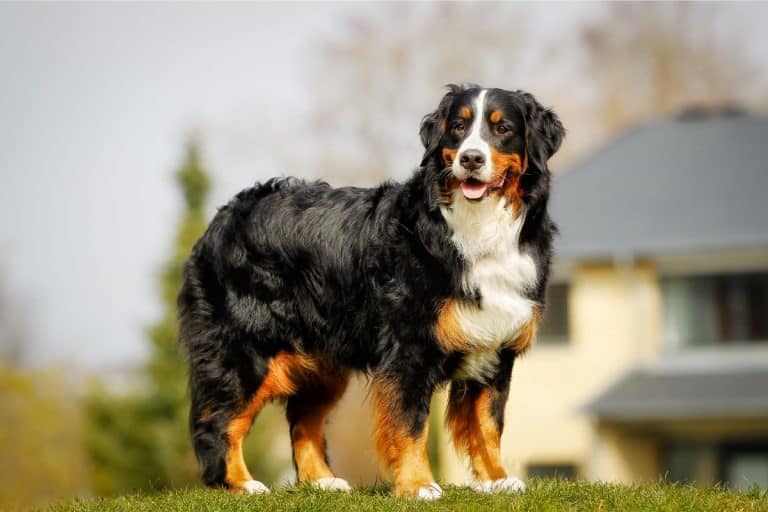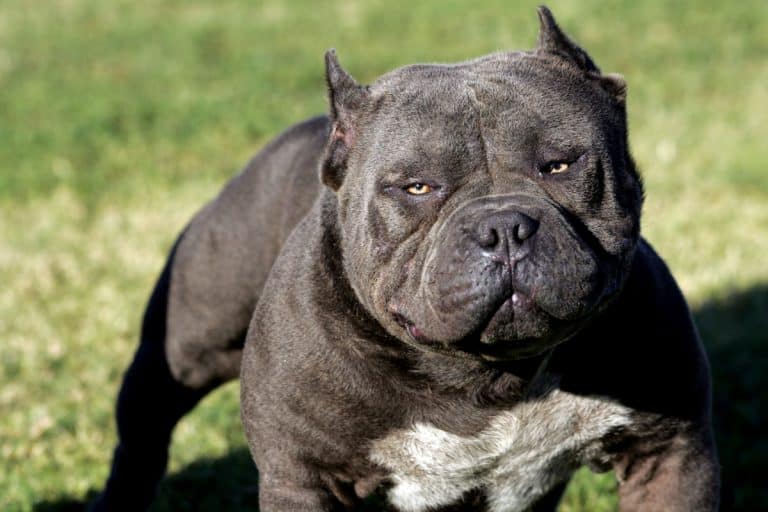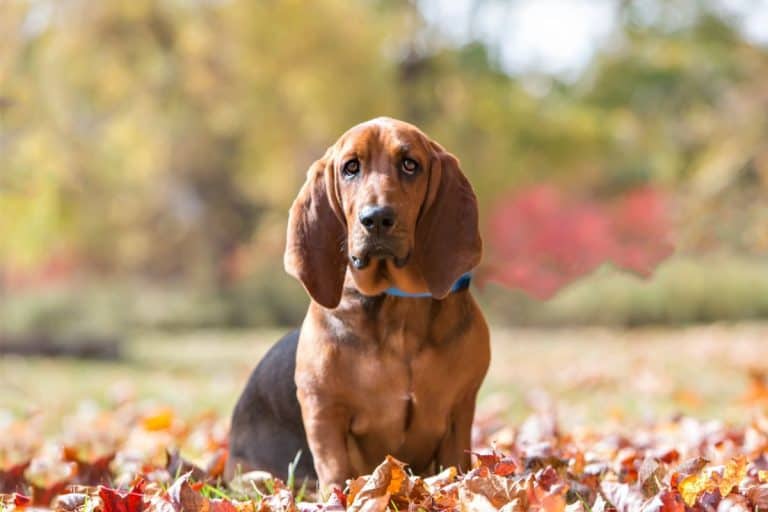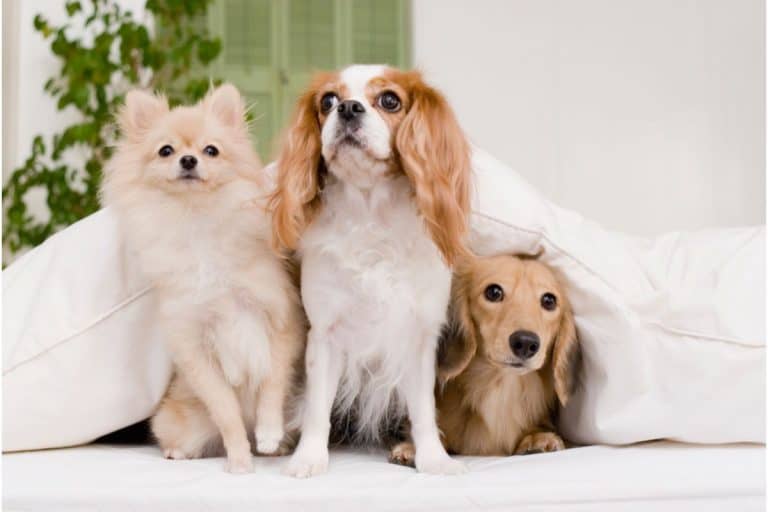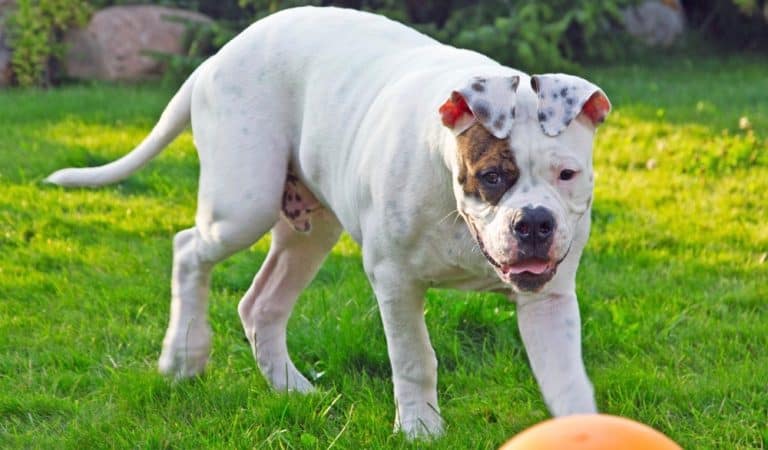Australian Cattle Dog vs Blue Heeler – Red Heeler vs Blue Heeler
What is the difference between Australian Cattle Dog vs Blue Heeler? This is a question many dog lovers have. Well in simple terms, there is no difference between these dogs except only the color.
A Blue Heeler is an Australian Cattle Dog with a blue color. Australian Cattle Dog also comes in red color and they are referred to as Red Heelers.
Australian Cattle Dog is the generic name, but they can also be called Queensland Heelers, Red Heelers, or Blue Heelers, and were named Hall’s Heelers about 200 years ago.
The name “Heeler” was given to them because they would nip the heel of the cattle so that they can move.
Red Heeler vs Blue Heeler
Blue and Red Heelers come from the same breed and only color differentiates them. Let’s have a look at each dog:
Red Heeler
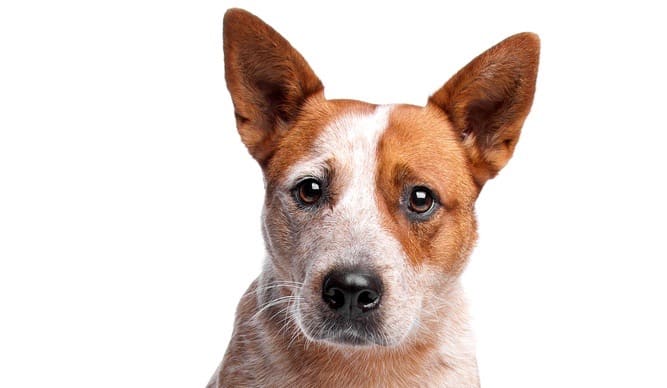
There are two subtypes of Red Heelers, red mottled and red speckled. The Red Speckled Heelers are differentiated by their white hairs that come out of the outer fur coat, irregular in shape, and big as a fingertip.
The white spots are slightly visible because of the dark red color of the underlying coat.
Red Heelers require speckled fur and distinctive color. Additionally, they have a masculine body which makes them agile, hyperactive, and strong.
When observed closely, their shoulders have stronger muscles, and they can grow to a height of 20 inches.
Red Heelers with mottled coat fur have a different background color which ranges from light red to ginger. Some Red Heelers have a red patch over both eyes while others have a patch over only one eye.
Blue Heeler
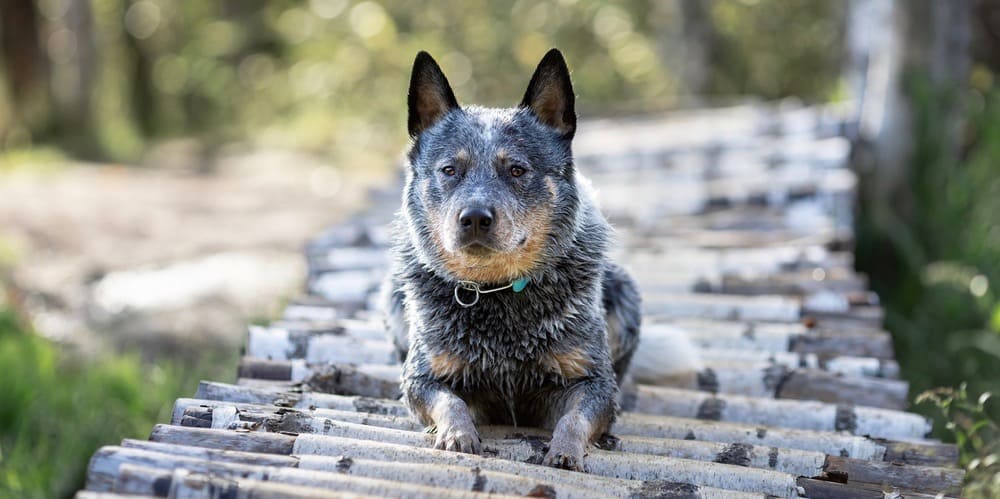
Like the Red Heelers, the Blue Heelers are equally agile, energetic, and ready to take care of the cattle. Since their blue color is darker, it is more difficult to locate them at night.
Their tail has a slightly lighter tail with a white spot which makes it easier for the owners to find them at night. This is due to the background coat color being darker than that of the Red Heeler.
However, when there are more speckles, the glaze of the dark blue coat is less visible.
Another distinctive feature of the Blue Heelers is the black hair with a tan shaded coat inside the hind and forelegs. The tan shade in Blue Heelers is more visible and can be seen on the breasts and throat compared to the Red Heelers.
The blue molted skin coat is the same as the one in Red Heelers in terms of color and size of the spots, white plus fingertip.
However, the skin coat color is either black or blue. They also boast a double or single mask over their eyes.
What Makes Australian Cattle Dogs Special
The cattle rearers in Australia need to move cattle from one region to another, and cattle dogs provide the required help.
Cattle dogs have certain traits including stamina, intelligence, energy, perseverance, and apt decision making, which are present in heelers.
Cattle dogs should be steadfast and ensure that even the most annoying and stubborn cattle behave well like the others. Thomas Hall cross-bred a cattle dog when no dog fit the bill of all the above traits.
And the Red and Blue Heelers were bred where the only difference is the color which is due to genetics.
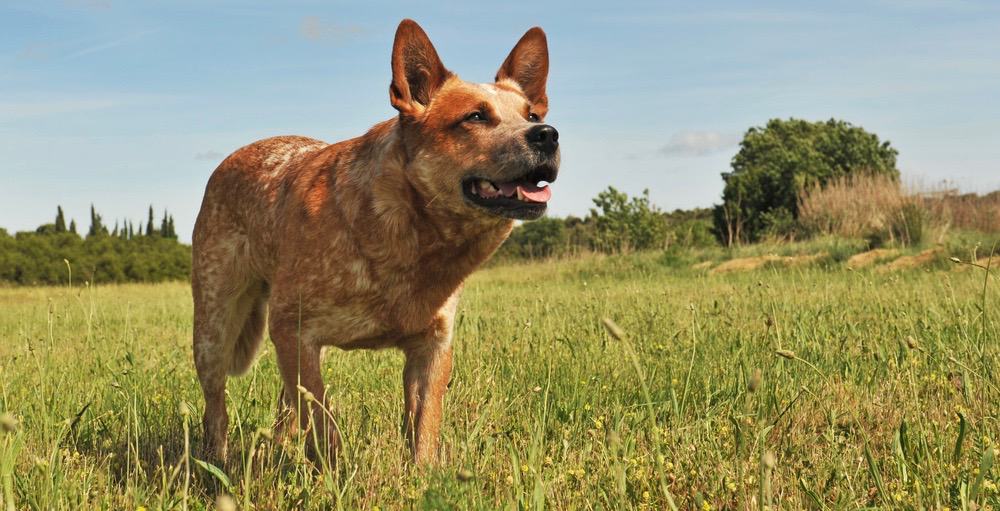
Finally, Australian Cattle Dogs require minimum maintenance as they are a wash and wear type of dog because of their tightly packed and short inner coat that keeps them warm.
Their topcoat is also denser and harder making it resistant to dirt and rain.
What Determines An Australian Cattle Dog Color?
The coat color of Australian Cattle Dogs is determined by the type of genes they carry. The coat color of puppies is not predicted by the coat color of the parents as two blue coat parents can have a red coat puppy.
The most important genes in Australian Cattle Dogs are spotting (S), agouti (A), and ticking (T). Puppies and modify to red or blue because of the ticking (T) gene which is dominant.
The red or black patches, primarily on the face are because of the agouti (A) gene carried by the puppy. What determines where the white spots will be in the body is the spotting (S) gene.
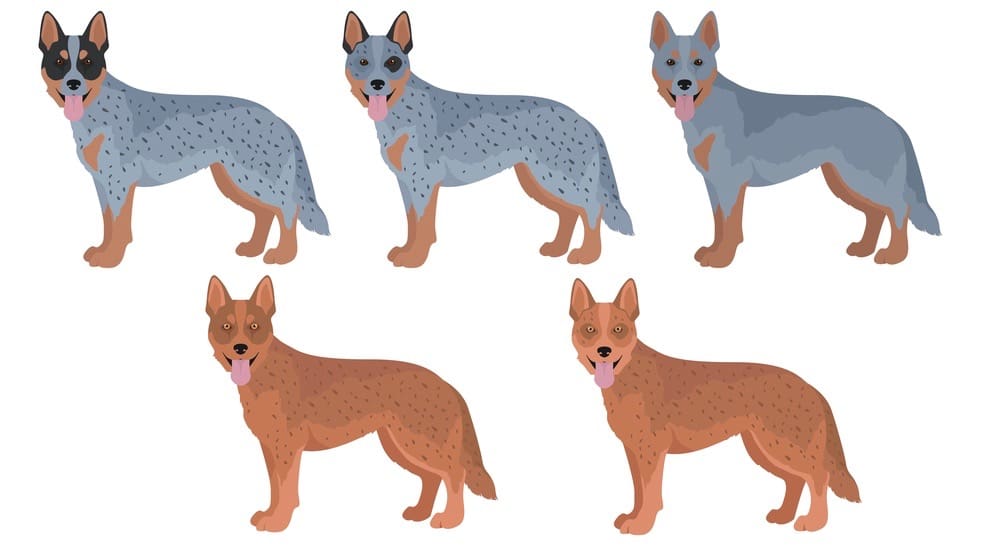
What Age Does An Australian Cattle Dog Puppy Get Their Color?
All Australian Cattle Dog puppies are white when they are born but some can have solid patches on the body and head because of the inherited Dalmatian gene. The blue and red hairs start showing at around the age of 4 weeks.
When the puppy reaches 8 to 12 weeks old, the red or blue colors become dominant.
Can The Australian Cattle Dog Be Domesticated?
With proper support and training, even the most hyperactive and fierce heelers can live in harmony with families. However, domesticating these dogs comes with a lot of work.
Before domesticating an Australian Cattle Dog, you should understand that they were bred specifically to help drovers, herders, and ranchers control their cattle without a break.
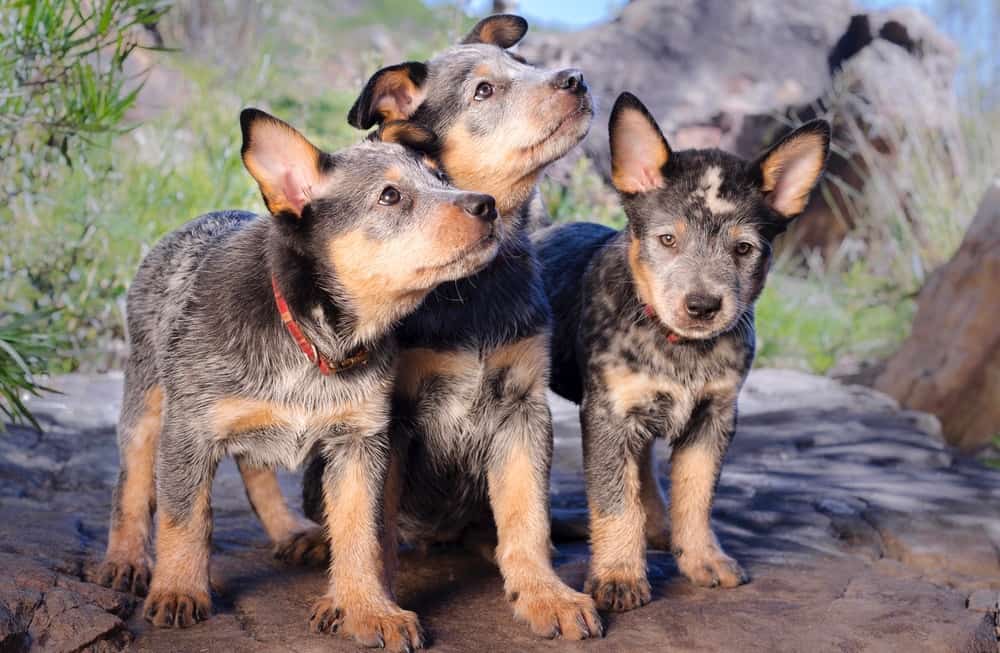
They were meant to be quick, strong, muscular, and always on the run. This means that they should have something to do all the time, otherwise, they will channel their excess energy on other things which sometimes can be very destructive.
Therefore, if you choose to domesticate an Australian Cattle Dog, be ready to keep them busy throughout the day. This is because the heelers are on the move constantly like clockwork and only rest when they are tired.
Breeds That Make Up The Australian Cattle Dog
In the 1800s a capable and working dog that could handle a harsh environment was needed in the Australian countryside.
George Elliott from Queensland bred the now-extinct Smithfield with the Dingos, local wild dog. Then they were crossed with the blue merle Highland Collie.
Later Harry and Jack Bagust from Sydney mixed these dogs with the Dalmatian to make them more comfortable for people and horses.
To make them a working dog, they were then mixed with the Kelpie. This resulted in the ancestor of the modern-day Australian Cattle Dog.
Australian Cattle Dog Training
Training an Australian Cattle Dog can be complicated, time-consuming, and laborious, but it is possible.
The fact that these dogs are fast learners and intelligent, training them continuously will mold them in a way that they feel happy, comfortable, and content in an urban or suburban household.
Throughout the training, you should use most of your energy on socialization and obedience training.
Remember, they are naturally born to become herd control dogs and to them, any animal or man is an object to be controlled as this is their basic instinct.
The Australian Cattle dog can easily be trained if their control-oriented behavior is kept under the hood. For this to be possible, training should begin as early as eight weeks old.
Get professional help if you need help training them because they know what works to train the dog and can leverage positive reinforcements.
Participation in activities such as herding, obedience, and agility is highly recommended, and doing them together fosters the bond between the two of you and can also be fun.
Remember, an energetic, intelligent dog will become bored if not kept occupied, and an energetic, bored dog can become very destructive.
Australian Cattle Dog Temperament
The Australian Cattle Dog loves herding animals, is extremely loyal to their human, and is good with small children. They love to play and run around as they have plenty of energy.
They can be a bit wary of strangers even and they are extremely loyal to their families.
Australian Cattle Dog Grooming
The Australian Cattle Dog has a double-layered, smooth coat that protects him from environmental elements. This dog was bred to work in the outdoors.
Since their coat does not have an oily residue or odor, they need an occasional bath and a quick brushing once per week, though, they shed their undercoat twice per year.
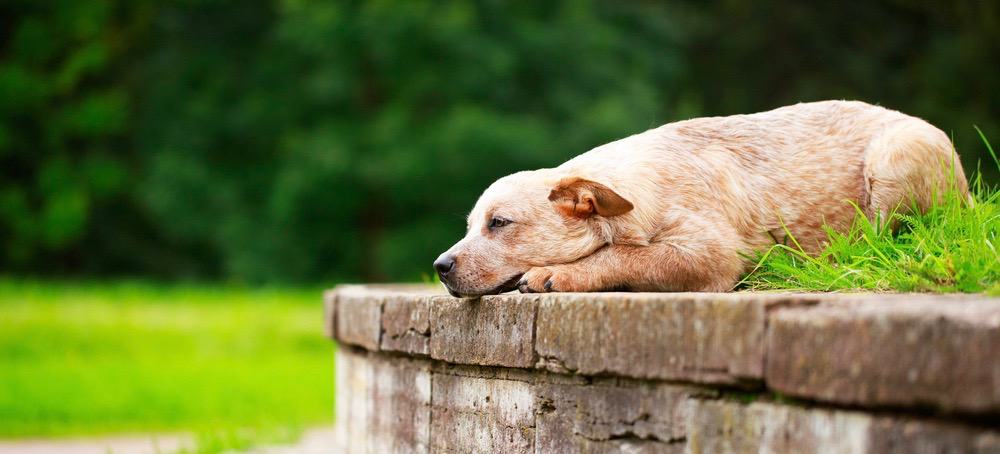
During the shedding season, use a short-bristle brush and a comb to thoroughly brush out and remove the dead hair every few days.
Like all the other breeds, Australian Cattle Dog’s nails should be regularly trimmed, ears checked regularly to avoid build-up of wax and remove any foreign matter, and their teeth should be regularly brushed.
Australian Cattle Dog Exercise
The Australian Cattle Dog is a very high-energy, active dog that needs more than just playtime in the yard and a quick walk.
They need a job to remain healthy and happy. If you have a working farm, this may not be a problem especially if they are herding animals.
In other living conditions, taking them for runs with you nearly every day or every day is a good way of letting their energy out.
The best choice is for them to participate in dog sports where you and your dog take part in activities such as agility or obedience to channel their abundant energy and drive in a fun way.
Australian Cattle Dog Nutrition
The Australian Cattle Dog should be fed high-quality dog food whether home-prepared or commercially manufactured with the approval or supervision of your vet. Any diet should be appropriate for your dog’s age whether senior, adult, or puppy.
Since Australian Cattle Dogs are active, athletic canines, ensure that they are getting good food that satisfies their nutritional requirements.
They should be fed lean protein, healthy fats, and good carbohydrates. Research on what human foods is safe for them and which ones are dangerous.
Consult your vet if you have any concerns with their diet and weight. Ensure that they have continuous access to fresh and clean water.
Australian Cattle Dog Health
Australian Cattle Dogs are generally healthy dogs, and any responsible breeder should screen the breeding stock for any health issues.
The most popular orthopedic health conditions with this breed are elbow dysplasia, hip dysplasia, osteochondritis, and luxating patella.
Progressive retinal atrophy (PRA) is the most serious eye illness that affects the Australian Cattle Dog which can happen when they are between the ages of three and six.
Fortunately, you can do a simple DNA test to know whether your dog carries the disease, has the disease, or is clear of it completely.
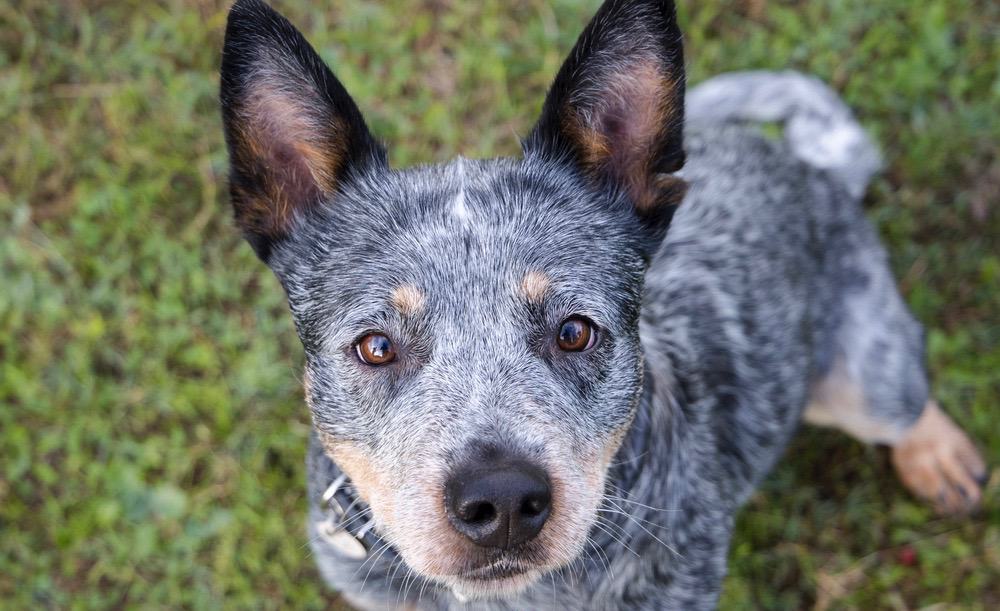
Other eye problems to watch out for are glaucoma, luxation, occasional retinal dysplasia, and cataracts. Epilepsy, heart disease, inherited deafness, and liver shunt can occur in some Cattle Dogs.
Allergies can lead to bacterial infection and itchy skin. Some Australian Cattle Dogs can also have hypothyroidism.
Daily routine check-ups, exercise, and healthy eating can help keep your Australian Cattle Dog in a healthy condition.
Facts About Australian Cattle Dog
Whether you already own an Australian Cattle Dog or thinking about getting one, the following are the things that you should about them:
- They weigh between 30 to 62 pounds and males stand at a height of around 17 to 20 inches while the females stand at a height of around 17 to 19 inches.
- They have a lifespan of between 12 to 15 years.
- They have an average litter size of 5 puppies.
- They are the most intelligent breeds around.
- They have a dense double coat.
- They descended from dingoes who are dated as far back as 1500 BC.
- They are bred to specifically work with cattle.
- They were accepted into the American Kennel Association in 1980.
- A heeler holds the Guinness Record of the oldest dog. Bluey from Victoria, Australia lived for 29 years and 5 months.
Final Words
From this article, you should now know that the Blue Heeler vs Australian Cattle Dog is the same dog. The Red Heeler is also an Australian Cattle Dog with a red coat.
Both the Red and Blue Heelers are active dogs who have become an important part of the cattle herders and ranchers all over the world and not only in Australia.
The versatile skin and ability to withstand extreme weather conditions make them a native to any region or country.
Hopefully, this article has given you enough information about the Australian Cattle Dog or Blue Heeler or Red Heeler.

